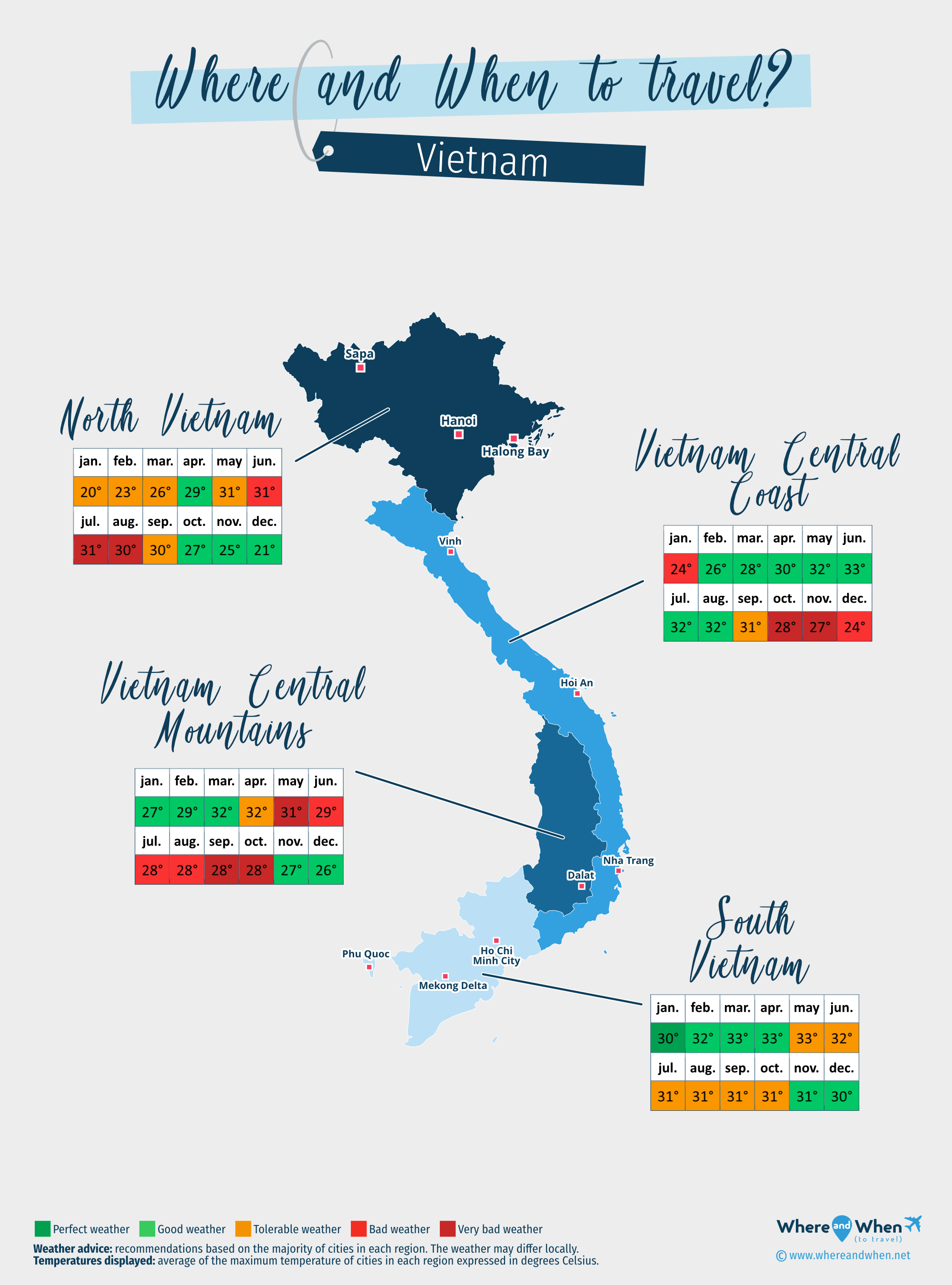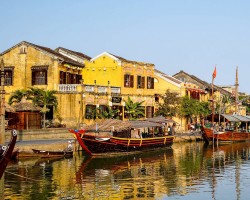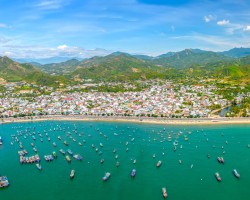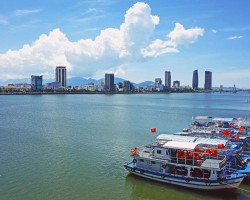Best time to go to Vietnam for a perfect weather and where to go?
When is the best time to go to Vietnam?
The best time to travel to Vietnam varies depending on the region visited and the travelers' interests.
In general, the period between November and April is considered the most favorable to visit the southern part of the country. It is the dry season: therefore, the weather is less rainy and the temperatures are pleasant. It is also the best time to enjoy the beaches. Indeed, Vietnam, with kilometers of coastline facing the South China Sea, has beautiful stretches where you can relax.
Moreover, it is advisable to avoid traveling to the south of Vietnam during the rainy season which occurs from May to September. The rains can be heavy, and floods can occur. The typhoon season from July to September should also be avoided.
On the other hand, if you want to discover the breathtaking landscapes of Halong Bay and the city of Hanoi in the northern part of the country, you should prefer the months from September to December. The climate will be ideal, with dry weather and temperatures ranging from 20 to 30°C (86°F) . However, the north should be avoided from January to March as temperatures are cooler, especially at night. The weather is also very cloudy during this period.
In the central part of the country, the climate is generally rainier, especially in the city of Hoi An. To enjoy pleasant weather in this region, it is best to travel between February and April. The surrounding beaches are particularly welcoming during this season.
Overall, the best time to travel from north to south of the country is therefore between March and April. The climate is favorable across the entire territory with dry and sunny weather.
Traveling to Vietnam also means enjoying the numerous local festivities that do not always take place during the dry season. Indeed, thousands of tourists come every year to witness the celebrations of the Vietnamese New Year in February.
Finally, if you are wondering when to travel to Vietnam to avoid tourist crowds, know that it is entirely possible to plan a trip during the rainy season. The weather remains relatively decent during this period.
Where and when to go based on the weather?

North Vietnam
Hanoi, Sapa (North Vietnam), Halong Bay...
South Vietnam
Ho Chi Minh City, Phu Quoc island (Koh Trol), Mekong Delta...
Vietnam Central Coast
Hoi An, Nha Trang, Vinh...
Vietnam Central Mountains
Dalat, Buon Ma Thuot, Pleiku...
To get all the information about the climate and weather in Vietnam for a specific month, click on the corresponding link below:
Vietnam in january Vietnam in february Vietnam in march Vietnam in april Vietnam in may Vietnam in june Vietnam in july Vietnam in august Vietnam in september Vietnam in october Vietnam in november Vietnam in december
Best time to travel to Vietnam by cities
Climate and Weather in Vietnam
Bordering China, Laos, and Cambodia, Vietnam, like many countries in Southeast Asia, benefits from a hot and humid climate over almost the entire territory.
Indeed, Vietnam has a tropical climate in the South and a subtropical climate in the North. It is influenced by the different monsoons. In the plains, high humidity is often found, while in the mountains, such as Sapa and Dong Van, the climate is milder and drier.
The climate in Vietnam is characterized by the alternation of two seasons:
- a dry and sunny season, which occurs more in winter
- a wet season, where temperatures are higher, in summer
Of course, the dry season is preferred for traveling to Vietnam. However, although the wet season often scares tourists, it is entirely possible to visit Vietnam during this period.
Indeed, rain does not fall all day during the rainy season (or monsoon) in Vietnam. Precipitation mostly occurs in the late afternoon or at night, in the form of showers. This makes tourist visits and outdoor activities possible. Moreover, these rains bring a particularly enjoyable freshness.

The weather in Vietnam varies greatly from one region to another. Let's explore these climate variations, region by region.
Climate in northern Vietnam
The climate in northern Vietnam, such as in Hanoi or Halong Bay, experiences what is known as the "Vietnamese winter."
This period, from November to early May, has a cooler weather with temperatures ranging from 20 to 30°C (86°F) during the day, which can drop further at night. However, the weather is generally gray and rainy in this area, making it a bit gloomy. Continuous light rain can be unpleasant for visitors and photographers.
The months of November and December, when precipitation is lowest, are preferred.
Moreover, in the northwest, in the mountainous regions, the climate is more pleasant, with higher temperatures and less rain.
Summer, on the other hand, lasts from May to September. It corresponds to the wet season with 15 or more rainy days per month. Precipitation is very high in June, July, and August. Additionally, it is the hottest period with temperatures often exceeding 30°C (86°F) during the day. The air humidity and constant heat make the atmosphere quite humid. During this period, particularly powerful typhoons can hit the coast and cause damage.
Climate in central Vietnam
Central Vietnam is as humid as the rest of the country, but precipitation is even higher between November and late January. Indeed, the wet season is shifted compared to the north.
This region also experiences a summer monsoon from May to November. This period sees the highest temperatures, especially between May and August, when the mercury often rises above 30°C (86°F) in this part of Vietnam. On the Central Highlands, one can enjoy more pleasant temperatures than on the coast.
Beware of typhoons that can form between September and October, during the monsoon changes. The city of Hue, in particular, suffers greatly from floods during this time of the year.
Therefore, the best time to visit this region is mostly between February and May. It is the driest and sunniest season with mild temperatures.
Finally, this is where you can find the city considered the most pleasant in terms of weather in Vietnam. Indeed, Nha Trang enjoys a particularly pleasant microclimate with lots of sunshine and high temperatures. The climate is favorable from January to September.
Climate in southern Vietnam
Southern Vietnam, around Ho Chi Minh City or Phu Quoc Island, experiences a dry and sunny period between November and April. The driest month is February. Additionally, with average temperatures ranging between 30 and 36°C (97°F) , the hottest months of the year are March and April. This heatwave heralds the wet season...
Indeed, the rainy season lasts from May to September. It is characterized by an increase in precipitation, reaching its peak in July. Therefore, summer is a period to avoid if you plan to stay in southern Vietnam. For example, Phu Quoc Island becomes impassable due to heavy rains during this period.
Lastly, one must be cautious regarding the Mekong River floods, which can be quite significant in August and September.
Temperatures and rainfall in Vietnam
On these 3 graphs, we present the evolution of temperatures of Vietnam and month-by-month rainfall for the cities of Hanoi, Dalat, Halong Bay, Ho Chi Minh City and Hoi An, as well as the month-by-month sea temperature for coastal cities.
Peak visitor numbers and tourist seasons in Vietnam
Find out when Vietnam has its high tourist season (the period when the influx of tourists is highest) and off-peak tourist season using our data and figures.
Tourist seasons in Vietnam
The months with low numbers of tourists are: March, April, May, June, September and October. The number of visitors to Vietnam is high in: January, February, July, August, November and December.
- Very low season in Vietnam: May, June, September and October.
- Low season in Vietnam: March and April.
- High season in Vietnam: February, July, August and November.
- Peak season in Vietnam: January and December.
Figure: Visitor index for Vietnam month by month
Average price for flights to Vietnam
A return flight between Sydney and Ho Chi Minh City is generally cheaper if you go in march ($ 455 on average): this is the best time for travellers on a tight budget. In contrast, you may end up paying $ 291 more for your airline ticket to Ho Chi Minh City if you go in december.
Find the best price for your flight Flight prices to Vietnam
Where to go in Vietnam?
This table allows you to see the maximum temperature for each city and our opinion on the weather month by month (see colour legend below the table).
| Cities | jan. | feb. | mar. | apr. | may | jun. | jul. | aug. | sep. | oct. | nov. | dec. |
| Hanoi | 72°F | 77°F | 83°F | 88°F | 95°F | 99°F | 95°F | 94°F | 92°F | 86°F | 83°F | 74°F |
| Dalat | 76°F | 79°F | 85°F | 85°F | 85°F | 81°F | 79°F | 79°F | 79°F | 77°F | 77°F | 76°F |
| Halong Bay | 68°F | 72°F | 76°F | 81°F | 86°F | 90°F | 90°F | 90°F | 88°F | 83°F | 77°F | 70°F |
| Ho Chi Minh City | 92°F | 95°F | 97°F | 97°F | 95°F | 92°F | 90°F | 90°F | 90°F | 90°F | 90°F | 90°F |
| Hoi An | 74°F | 77°F | 83°F | 86°F | 90°F | 92°F | 90°F | 90°F | 88°F | 83°F | 79°F | 76°F |
| Nha Trang | 79°F | 81°F | 85°F | 86°F | 90°F | 90°F | 90°F | 90°F | 88°F | 85°F | 83°F | 79°F |
| Phu Quoc island (Koh Trol) | 85°F | 85°F | 86°F | 86°F | 88°F | 86°F | 86°F | 86°F | 85°F | 85°F | 86°F | 85°F |
| Sapa (North Vietnam) | 72°F | 76°F | 81°F | 85°F | 86°F | 85°F | 83°F | 83°F | 83°F | 79°F | 77°F | 72°F |
| Vinh | 70°F | 76°F | 81°F | 86°F | 94°F | 95°F | 94°F | 92°F | 90°F | 83°F | 79°F | 72°F |
| Buon Ma Thuot | 83°F | 90°F | 95°F | 95°F | 94°F | 88°F | 86°F | 86°F | 86°F | 86°F | 85°F | 83°F |
| Da Nang | 74°F | 77°F | 83°F | 86°F | 90°F | 92°F | 90°F | 90°F | 88°F | 83°F | 79°F | 76°F |
| Huế | 76°F | 79°F | 85°F | 88°F | 94°F | 95°F | 94°F | 92°F | 90°F | 85°F | 81°F | 76°F |
| Mekong Delta | 88°F | 94°F | 97°F | 95°F | 94°F | 92°F | 90°F | 92°F | 90°F | 90°F | 90°F | 88°F |
| Phan Thiet | 86°F | 88°F | 92°F | 92°F | 94°F | 92°F | 90°F | 90°F | 90°F | 88°F | 88°F | 88°F |
| A Pa Chai | 70°F | 77°F | 83°F | 86°F | 86°F | 81°F | 81°F | 83°F | 83°F | 79°F | 76°F | 70°F |
| Bac Ha | 67°F | 76°F | 83°F | 88°F | 90°F | 88°F | 86°F | 86°F | 85°F | 79°F | 76°F | 68°F |
| Bai Lang (Cham islands) | 74°F | 77°F | 83°F | 86°F | 90°F | 92°F | 90°F | 90°F | 88°F | 83°F | 79°F | 76°F |
| Bãi Xép Beach (An Chấn) | 77°F | 79°F | 85°F | 88°F | 92°F | 92°F | 90°F | 90°F | 88°F | 85°F | 83°F | 79°F |
| Cat Ba island | 67°F | 70°F | 74°F | 79°F | 85°F | 88°F | 88°F | 88°F | 86°F | 83°F | 77°F | 70°F |
| Cat Tien National Park | 92°F | 95°F | 97°F | 95°F | 94°F | 90°F | 88°F | 88°F | 88°F | 88°F | 90°F | 90°F |
Legend:
perfect weather
good weather
tolerable weather
bad weather
very bad weather
About Vietnam
What can I do in Vietnam?
Beaches / swimming
Nature and countryside
Culture and heritage
Sports
Family travel
Crafts / shopping
Gastronomy
Nightlife
Is this weather information for Vietnam reliable?
Climate data for Vietnam has been gathered every day since January 2009. The analysis of these meteorological data for Vietnam allows us to determine the average for each month in Hanoi, Dalat, Halong Bay, Ho Chi Minh City, Hoi An, Nha Trang, Phu Quoc island (Koh Trol), Sapa (North Vietnam), and 68 other cities.
So yes: this data is reliable except in cases of temporary climate disruption in the region.














